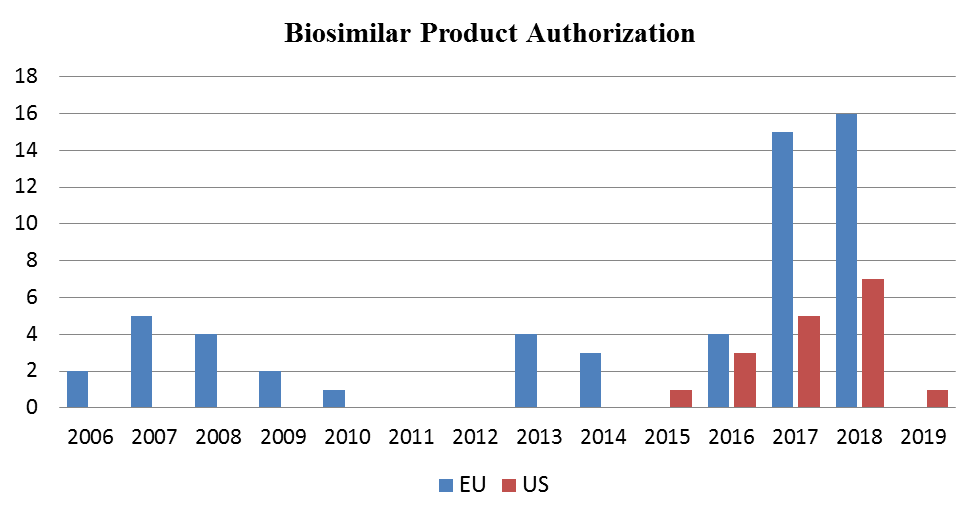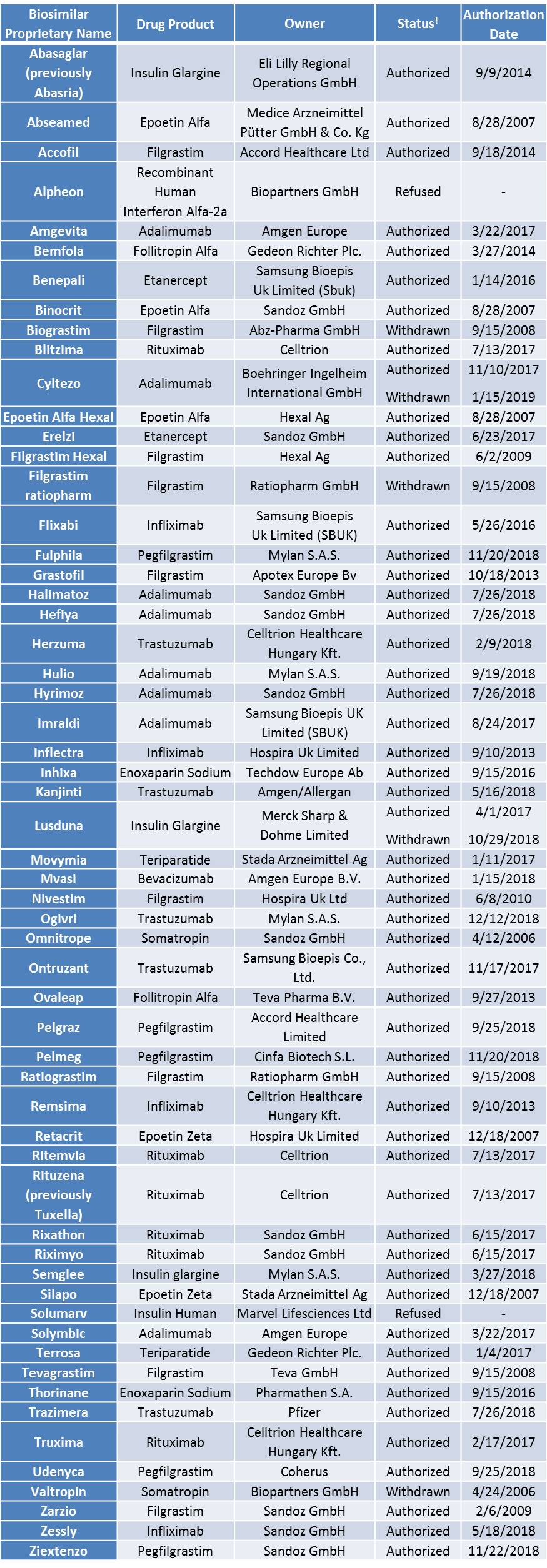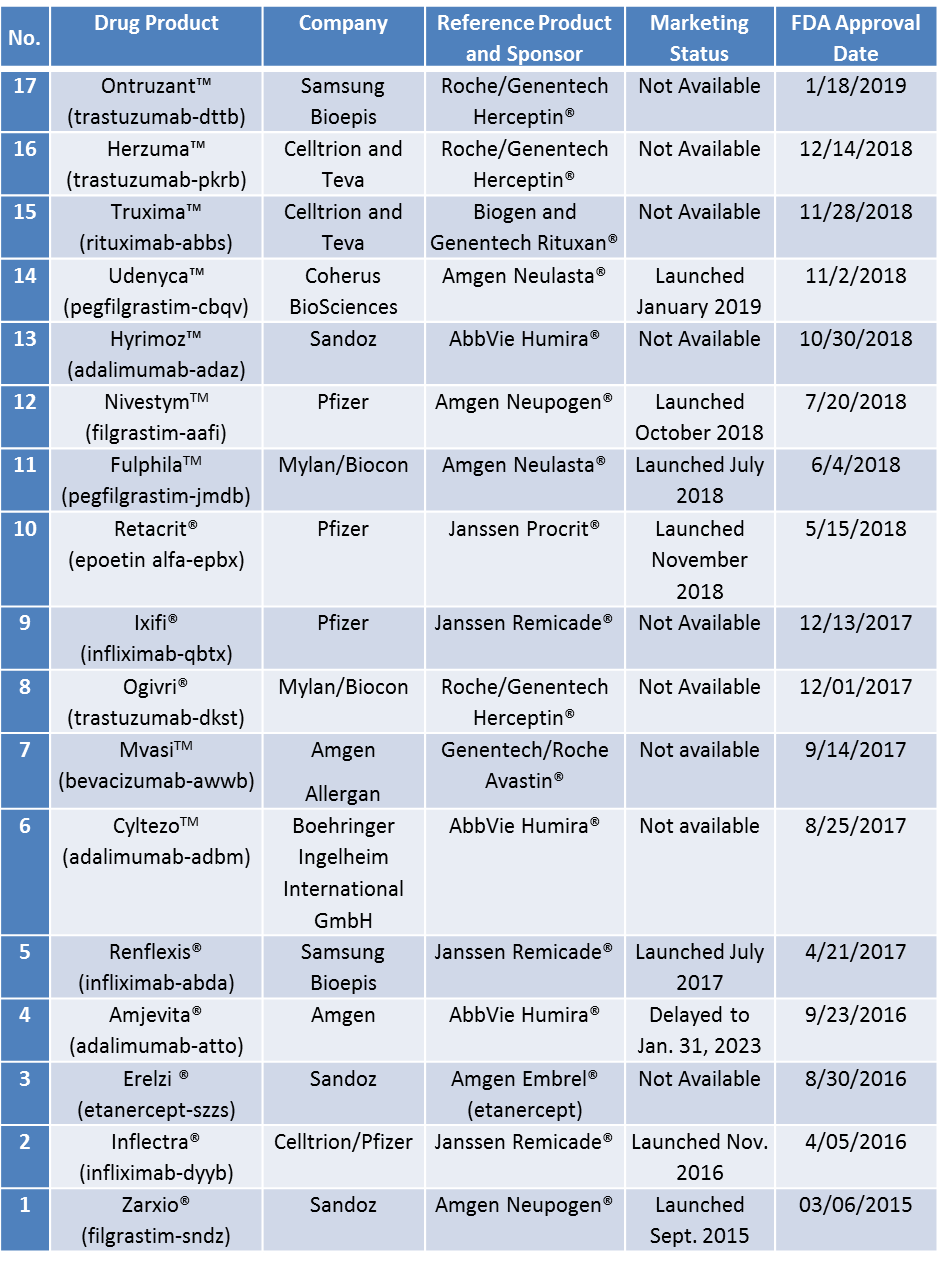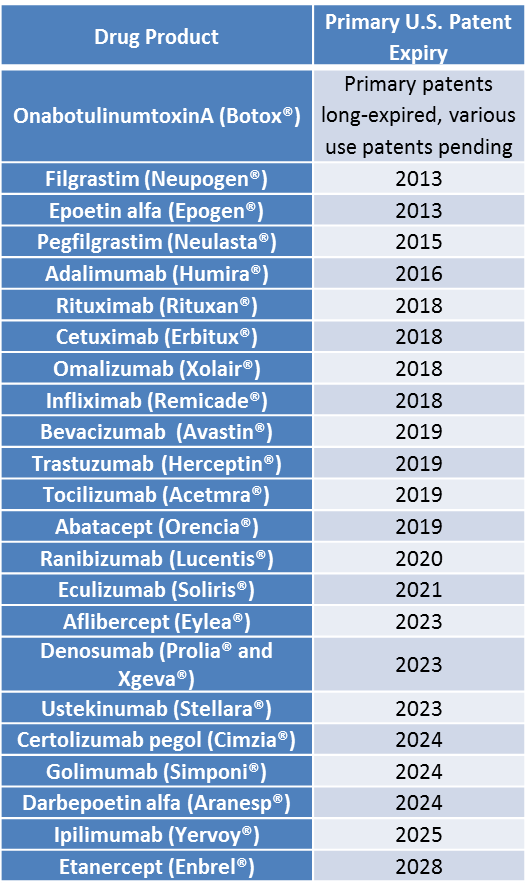- Coherus launches UdenycaTM, a pegfilgrastim biosimilar, in the United States.
- Pfizer launches Retacrit®, an epoetin alfa biosimilar, in the United States.
- FDA approves the first rituximab biosimilar, although it has not yet launched in the United States.
- European Medicines Agency approves third, fourth, and fifth pegfilgrastim biosimilars and a fifth trastuzumab biosimilar, while withdrawing approvals for an insulin glargine and an adalimumab biosimilar.
As pharmaceutical drug costs attract increasing media attention and political scrutiny, a growing number of biosimilar drugs are set to enter the U.S. and European markets in the coming years. Global sales for the top ten branded biologic drugs totaled approximately $71 billion in 2017[1]. In July 2018, Health and Human Services Secretary Alex Azar announced a Biosimilars Action Plan to aid the development of a market for biosimilars in order to increase competition for biologic drugs, which make up 40% of U.S. pharmaceutical spending. Competition in the heavily regulated marketplace for these blockbuster therapeutics is expected to substantially impact the pharmaceutical industry and national health systems. To date, the U.S. has considerably lagged behind Europe’s expansion of biosimilar drug options. The RAND Corporation estimates that biosimilar products can save the U.S. health system approximately $54 billion over the next decade, as discussed here.
Since 2005, the biosimilar regulatory framework in Europe has been implemented through the Committee for Medicinal Products for Human Use (CHMP) under the European Medicines Agency (EMA). The CHMP provides initial assessments for marketing authorization of new medicines that are ultimately approved centrally by the EMA. Since Sandoz’s somatotropin biosimilar Omnitrope® was first authorized on April 12, 2006, an additional 55 applications have been approved in Europe. Five of the authorizations have been withdrawn post-approval (Table 1).
The U.S. did not implement a regulatory framework for biosimilar evaluation until after enactment of the Biologics Price Competition and Innovation Act (BPCIA) of 2009. Given that the first U.S. biosimilar drug was approved almost a decade after the first in Europe, the number of authorized biosimilar drugs in Europe far exceeds the number of biosimilars approved in the United States. Sandoz’s filgrastim biosimilar Zarxio® received the first U.S. approval in 2015, whereas nine filgrastim biosimilars have been approved in Europe dating back to multiple authorizations in 2008. Zarxio® (in the U.S.) and Zarzio® (in Europe) are biosimilar to the reference product Neupogen® marketed by Amgen and originally licensed in 1991. Subsequent to Zarxio®’s approval, 16 other biosimilar drugs have gained U.S. approval to date (Table 2).
As illustrated in the following graph, while the EU’s significant head start led to an imbalance in the number of biosimilar drugs available in the respective markets, the EU’s relatively higher rate of approvals in recent years has widened its lead over the United States.

Currently, seven biosimilar applications are under review by the EMA for marketing authorization (Table 3). As an increasing number of patents expire on blockbuster biologic drugs, the number of abbreviated biologics license applications is also increasing. Biosimilars for at least 23 different original biologics are currently navigating biosimilar pathways or are in late stage development in the U.S. (Table 4).
In November 2018, the EMA approved three pegfilgrastim biosimilars to Amgen’s Neulasta® in Europe. In December 2018, the EMA approved Mylan’s Ogivri, which is the fifth trastuzumab biosimilar to Roche and Genentech’s Herceptin® approved in Europe.
Two EMA biosimilar approvals were also withdrawn in late 2018 and 2019: Merck’s insulin glargine biosimilar Lusduna was withdrawn in October 2018 and Boehringer Ingelheim’s adalimumab biosimilar Cyltezo was withdrawn in January 2019.
Biosimilar approvals by the FDA accelerated in late 2018, with approval of Sandoz’s adalimumab biosimilar Hyrimoz™, Coherus’ pegfilgrastim biosimilar Udenyca™, Celltrion’s rituximab and trastuzumab biosimilars Truxima™ and Herzuma™, and Samsung Bioepis’s trastuzumab biosimilar Ontruzant™. Coherus launched Udenyca™ in January 2019, and the company reported that it is well-positioned in the $4 billion U.S. market for pegfilgrastim due to favorable reimbursement changes effective at launch and good adoption dynamics.
The FDA has recently provided useful guidance as reported here and available here. Under the leadership of Dr. Scott Gottlieb, the FDA has advanced new policies aimed at promoting more competition when it comes to biosimilar products as outlined in Dr. Gottlieb’s December 11, 2018 statement on new actions advancing the agency’s biosimilars policy framework.
Table 1. European Medicines Agency List of Approved Biosimilar Drugs (updated February 5, 2019).

Table 2. U.S. Food and Drug Administration List of Approved Biosimilar Drugs (CDER list of licensed biologics updated on February 1, 2019).

Table 3. European Medicines Agency List of Biosimilars Under Evaluation for Marketing Approval (Source: EMA list of applications for new human medicines updated on January 7, 2019).

Table 4. Biologics having already expired or nearing primary patent expiry in the U.S. and biologics that have biosimilars in the regulatory pipeline.

[1] Based on sales reported by respective manufacturers (1. Humira—Abbvie, 2. Rituxan—Roche, 3. Enbrel—Pfizer/Amgen, 4. Herceptin—Roche, 5. Avastin—Roche, 6. Remicade—Johnson & Johnson/Merck, 7. Lantus—Sanofi, 8. Neulasta—Amgen, 9. Avonex—Biogen, 10. Lucentis—Roche/Novartis).
